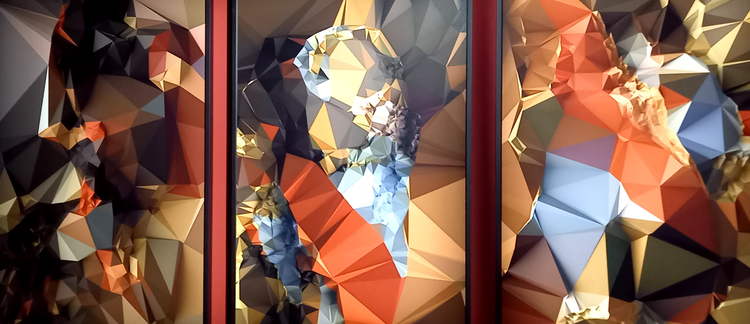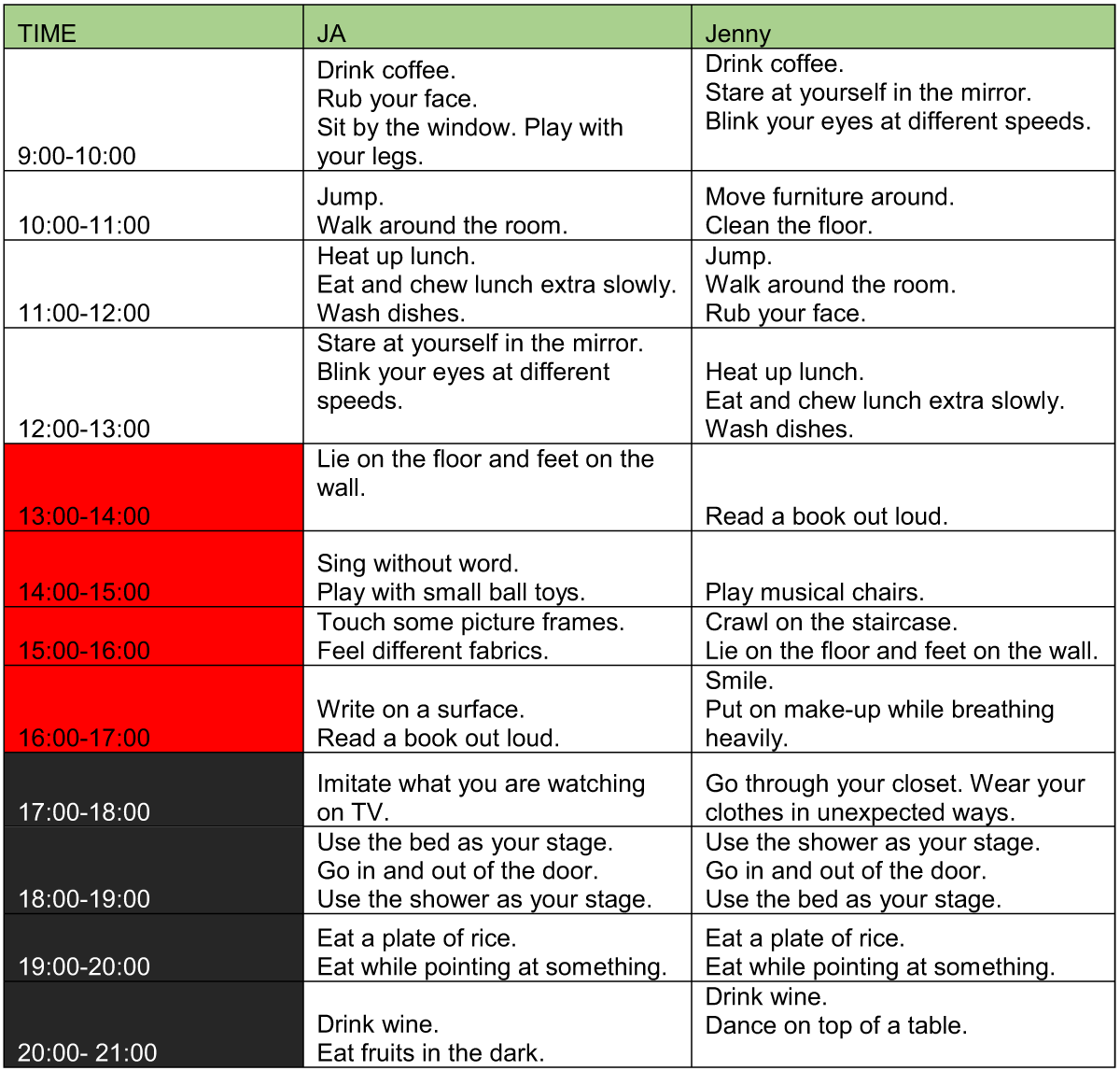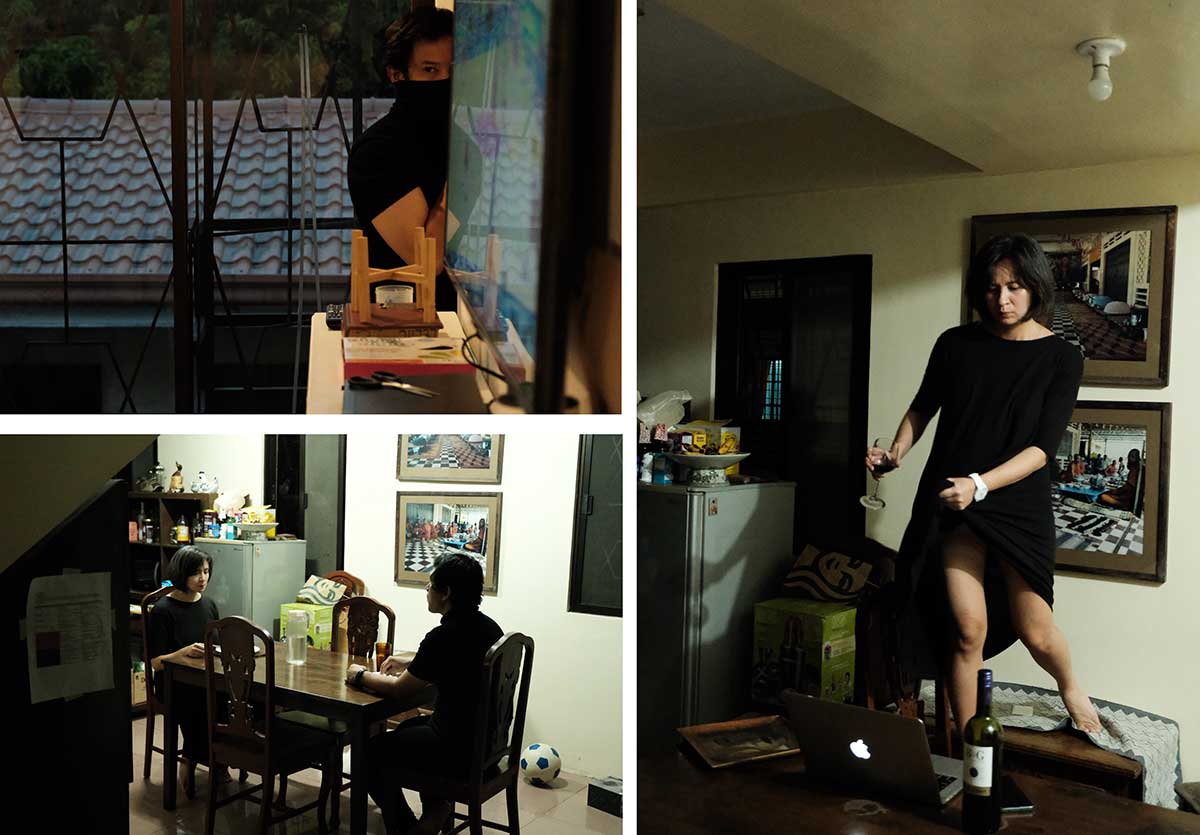Performance of Thread/Warp (Recording)
File: https://drive.google.com/file/d/1cjrX0z24LaELuR-8brVq4mkYYAasO8vM/view?usp=sharing
Introduction: To Perform Beyond What is Necessary
Thread/Warp was an online durational performance that investigated the idea of stamina amidst our performance-obsessed, techno-contemporary world. It was performed live in a span of twelve hours via Zoom (and occasionally streamed via Facebook Live), and featured two performers in separate screen windows as they navigated the spectacle and exploitation of their bodies in two intersecting spaces: 1) the confines and confidentiality of their private domestic space(s); and 2) the expansive and exposing nature of the public space via their relationship with the video cameras. Thread/Warp explored what it meant to sustain energy, tenacity, resilience, patience, and sustaining hope against hope—especially in a climate wherein we are relentlessly expected to perform beyond what’s necessary; to tirelessly create infinite yet exhausted spectacles of both our physical and virtual bodies; and to constantly amplify our human stamina in order to brutally compete with the stamina of technology itself.
Methodology and Approach
However, Thread/Warp was more than just an exploration into stamina per se. Rather, it investigated what stamina meant in the context of over-performance. In consideration of the extent and boundary of over-performance given our techno-contemporary milieu, this project utilized the concept of space as a crucial stimulus in conditioning one’s body to perform beyond what is necessary. Specifically, the project took into account two spaces that had radically shaped our relationship with stamina —the private and the public—no longer as two distinct and separate entities, but rather as spheres that constantly intersected, overlapped, blurred, and at times even traded with one another. Thus, affecting a tremendous change in the dynamic, potency, and frailty of the performer’s body.
During the course of development of Thread/Warp, the project’s methodology dissected and (re)configured the role/s of private and public spaces, and how each contributed to the body’s state of over-performance.
Over-Performance in the Private Space
Work-from-home (WFH) is not a new concept per se as this has been an existing work model since the turn of the 21st century1. However, the COVID-19 pandemic, coupled by the stringent lockdown measures imposed (particularly by the Philippine government of which our piece is borne from2) have undeniably amplified and mainstreamed the WFH model for every possible sector or industry. This has, in turn, distorted the boundary between the domestic and public, resulting in a unique implosion of the over-performing body.
Considering this context, Thread/Warp engaged two performers to wander, navigate, and force spectacles within their private domestic spaces within the span of twelve hours. The actions they chose ranged from the most mundane (sit, jump, eat, etc.) to the most absurd (cook water, smile at the wall, whisper to your plants, and so on). All actions depended on 1) how prolonged the performance timeframe was 2) the limited confines and confidentiality of the private domestic space 3) how the performers pushed their boredom to the edge, and 4) how this boredom caused the performers to invent and sustain others forms of spectacles. This methodology examined the shifting conditions of the private domestic space – from a supposed place of rest and rejuvenation to a place of perpetual labor and recycled productions – and how these unprecedented changes either deflated or escalated our stamina.
Over-Performance in the Public Space (via Zoom and Facebook Live)
The element (and variations) of public exposure was vital in the discussion of stamina and over-performance. The performers catechised themselves with the following inquiries during the conceptualization phase: What were the degrees and manifestations of public exposure when it came to our performance-obsessed, techno-contemporary world? How did public exposure – along with its varying forms – affect the energy and endurance of the performer? Furthermore, how did these specific factors affect the performer’s perception and relationship with space, especially the private space?
With these questions in mind, Thread/Warp orchestrated two technological platforms: Zoom and Facebook Live. The former, Zoom, behaved as the constant and primary platform; a supposed private performance space that can be easily accessed by a publicly announced key (passcode). The public were given the choice to access, enter, and exit this Zoom space at any time during the twelve hour performance. While on the other hand, the latter, Facebook Live, was the variable platform that occasionally betrayed this make-believe privacy by divulging (without permission) parts of the performance to the Facebook public. By the interjection of these two platforms, the project explored two variations of public (over)exposure: one was exposure with consent, which constantly and shamelessly invited/lured the public to penetrate the private space (Zoom); while the other one was exposure without consent which capriciously and maliciously leaked the contents of this space to the unwitting public (Facebook Live). This methodology investigated how public exposure radically maneuvered our sense of stamina, and how this further warped and manipulated our relationship with rest, recuperation, production, performance, labor, and ultimately, individual purpose and meaning.
The Twelve Hour Itinerary
Derived from the month-long public rehearsals, a strict twelve hour itinerary was crafted by the creative team. Two performers were instructed to follow this itinerary chronologically and rigidly during the entire twelve hour performance. This meant maintaining discipline while combatting potential deterrents to the performer’s concentration and objectives.
Note: The color-coding under the time column indicates the color of costumes. Morning (9am-1pm) starts with white costume. Afternoon (1pm-5pm) proceeded with red costume. And evening (5pm-9pm) finished the day with black costume.
The entire performance happened in one location only, which was the house of the technical director and the female performer (art collaborators and husband-and-wife team, Blonski and Jenny Logico-Cruz). Given a strong personal attachment between the performance space and the creative team, this decision hoped to further tackle our conscious and deliberate invasion/s of privacy. The performance started out with the two performers engaging in separate activities in separate spaces in the house, somewhat creating an illusion that they do not exist in the same space. It is only in the last four hours of the performance that they started to intersect and merge each other’s spaces, affirming the reality that they are indeed existing in the same location, but are already at the point wherein they could no longer connect with each other, whether emotionally or spiritually.
Alongside this, the reverberation of a ticking clock accompanied the performers as their primary soundscape throughout the twelve hour duration.
Reflections on the Spectatorial Response(s) on the First Public Run of Thread/Warp (XSCENA Exhibition)
Thread/Warp premiered in the 1st XSCENA Scenography Exhibition3 (curated by the Production Design Department of De La Salle College of St. Benilde) on July 14, 2021. The XSCENA Scenography Exhibtion aimed at a multi-iteration of scenographic projects and explored various online platforms such as TikTok, Instagram, Zoom and Facebook Live. The line-up consisted of leading scenographers and theatre practitioners based in the Philippines.
The audience comprised of students, creative practitioners, and academic scholars. In observing the online audience traffic for Thread/Warp, most spectators sporadically entered the Zoom room throughout the twelve hour performance. Some audience members visited once or twice while others briefly surveilled every hour during the full twelve hours. Facebook Live garnered the attention of selected audience members to login to the Zoom room. In one instance, it even caught the attention of hecklers who attempted to disrupt the performance by turning on his/her audio and video. This prank only lasted for around three minutes since the hecklers failed to elicit any reaction from the performers4.
Two spectators remained logged onto the Zoom room for the totality of performance. These spectators kept Thread/Warp in the background while conducting their own tasks at home. To paraphrase from our post-show discussions, recurring questions such as ‘why am I watching this?’ as well as ‘am I intruding into these private spaces?’ resonated during their viewing experience. What triggered the audience’s discomfort was the occasional gaze transmitted by the performer toward the camera. The essence of stamina and privacy were, in turn, transferred to these specific spectators given their full participation of the event.
Technical Requirements
Central PC: This is where the Zoom room and Facebook Live were hosted. The Central PC contained a bigger storage as well, which enabled the team to store the twelve hour recording of the performance afterwards. This device was managed by the technical manager.
Two secondary devices: The two devices were operated by the two performers (one device per performer). These devices consisted of a laptop and a tablet because they had more Zoom features option compared to a phone.
Chargers/ power banks: Since the performance will last for twelve hours, the performers were required to prepare the necessary measures in case they needed to re-charge their devices.
Performance Timeframe: 8 AM- 8 PM (twelve hours)
Production Team
Company: Langgam Performance Troupe www.langgamperformancetroupe.com
Concept & Direction: Jenny Logico-Cruz
Performances by: John Andre Sarmogenes & Jenny Logico-Cruz
Technical Manager: Blonski Cruz
Notes
- On the history of the work-from-home model: https://www.sorryonmute.com/history-remote-work-industries/ [^]
- On the long COVID-19 lockdown in the Philippines: https://time.com/5945616/covid-philippines-pandemic-lockdown/ [^]
- On XSCENA Scenography Exhibition: https://www.facebook.com/xscena.exhibit [^]
- The hecklers can be seen on the time stamp, two hours and 21 minutes. They started to leave at around two hours and 23 minutes. The hecklers presumably spoke in Spanish, and conversed in the following translations: ‘I’m in an autobus. Trying to discharge’; ‘Run motherfucker’; ‘Son of a bitch’. [^]
Competing Interests
The authors have no competing interests to declare.
Author Information
Langgam Performance Troupe (LPT) is a Manila-based contemporary performance company focusing on experimental, process-based, and practice-as-research works. LPT envisions a performance collaboration that forges an integrated, dynamic, and progressive community of multi-disciplinary players who are seeking alternative theater and performance practices and methods of understanding cultural and socio-political themes. Website: www.langgamperformancetroupe.com
Jenny Logico-Cruz is a contemporary & experimental performance-maker. She has worked with notable institutions such as The Cultural Center of the Philippines, St. Scholastica’s College of Music, The National Asian American Theater Company, The New York International Fringe Festival, and The V&A Museum- Theatre and Performance Department. Jenny holds an MA in London’s Theatre and Performance (Viewing, Making, Writing) at the University of Roehampton where she received a distinction. She is currently a Faculty at the Theater Arts Department of De La Salle - College of Saint Benilde (Manila, Philippines), and the Artistic Director of Langgam Performance Troupe.
Blonski is a photographer and filmmaker based in the Philippines. He is a Production Design graduate from De La Salle – College of Saint Benilde. He holds certifications in Interior Design at the Philippine School of Interior Design and Project Management at the City, University of London. He was a recipient of production grants with the Goethe Institut, National Culture of the Arts, and Cinema One Film Originals. Blonski co-founded Langgam Performance Troupe with professional/personal partner Jenny Logico-Cruz. His directorial credits include Si Medea (2016), The Launch of Janus (2019), and The Head What Else (2020).






